It has been a few years since the idea of writing an essay about Sterling Hayden first came to my mind and I began collecting articles about him. I am not sure why I felt the need to write about this mostly forgotten actor except that some of his performances stayed with me for a long time. Then, after reading about him in various sources (New York Times, Sausalito Historical Society, Newburyport News, Wikipedia, others), as well as reading a biography of him and both his own autobiography and novel, I became increasingly fascinated by his life and consequently was compelled to write this blog post.
It is not always easy to summarize a life in a few pages. I am a devoted/obsessive reader of the New York Times obituary pages (the old joke, of course, is you do this to make sure your own name doesn’t appear) and I often stop to admire the skills of those who prepare obituaries for larger-than-life figures. I only came to realize how challenging it would be to contain Hayden’s life when I started preparing this essay. It is not terribly hyperbolic to note that Sterling Hayden was one of the most complex and interesting people of the 20th century who, despite his very public career, mostly shunned the limelight. He never finished high school but read an astounding number of books, including many classics of literature, both 20th century and before. An engrossing story could be told about each of the roles he played in life:
Sailor—Master seaman—Sailing ship’s captain—Barge master—Actor—Movie Star—Model—Boxer—Adventurer—Scholar—Linguist—Memoirist/Autobiographer—Novelist—Musician—Adventurer—Marine recruit—Marine officer—War Hero—Spy—Patriot—Communist—Individualist—Motorcyclist—Father—Kidnapper—Felon—Divorcée—Chain smoker—Pothead—Drunk—Cancer victim.
The first Sterling Hayden film I saw was John Huston’s The Asphalt Jungle. I think I was 12 or 13 years old and, even then, I was engrossed and knew it was a wonderful movie. I certainly didn’t realize it would, in time, become “one of the most influential” motion pictures in the crime and noir film genres.
John Huston was already renowned for his work as writer and director of another brilliant noir film, The Maltese Falcon, a decade before, but he meant nothing to me. The cast of The Asphalt Jungle was superb, including Marilyn Monroe in her first important role. In those days, however, I didn’t pay much attention to directors, producers, writers or any of the other key figures in creating movies. Monroe was just another starlet. The story was the important, and only element, for me.
I knew about one of the actors, Sam Jaffe, who had earned renown for his role as Gunga Din in Frank Capra’s film of that
name, which I may have seen about the same time (my recall of these things is not perfect) I saw Asphalt Jungle. I also knew of Jaffe because my mother, a fervent fan of movies, told me about him, noting he was a great actor and that he was Jewish (it was a time, similar to now, when Jews were targeted for various reasons and my mother often reminded me of the Jewishness of accomplished people whose names appeared in newspapers or magazines). Louis Calhern was another cast member known to her. Jean Hagen, James Whitmore and John McIntyre filled out the outstanding cast. Monroe had a lesser, but memorable, role.
But the lead actor was Sterling Hayden, whose name I had not heard before and, for years after, could not always remember except for hearing that he was labelled a poor actor, a reputation he himself often emphasized and a reputation about which he was wrong. In contrast, many critics of the time thought he was excellent in his many performances (as I did). He became famous in the years after World War II for playing both heroic and dark anti-hero roles, as well as villains. His powerful intensity, imposing height (6 feet 5 inches) and handsome features made him a powerful screen presence. His physicality lent great strength to the many characters he played, several of whom battled to balance a sense of humanity with a troubled past and, often, violent tendencies. He has been called “one of the most highly regarded character actors in American cinema.”
If you don’t know of Sterling Hayden from his early years you may recall him from one of the films he made in his later years. His brilliant, comic portrayal of General Jack D. Ripper, in Stanley Kubrick’s Dr. Strangelove or How I Learned to Stop Worrying and Came to Love the Bomb, was praised by many critics and is another of Kubrick’s high memorable films. A few years after, also to excellent reviews, Hayden vividly portrayed the corrupt and cruel police chief, Capt. McCluskey who is shot by Michael Corleone (Al Pacino) to avenge the attempts to kill Michael’s father, Vito Corleone (Marlon Brando), in Francis Ford Coppola’s The Godfather
Hayden was born March 16, 1916, in Upper Montclair, New Jersey, as Sterling Relyea Walter. His father died
when Sterling was 9 years old and his mother married James Hayden who adopted the boy, renaming him Sterling Walter Hayden. James Hayden was a conman. He always had a deal in the making, promising his family wealth and stability, neither of which he ever provided. They changed homes regularly, usually to one after another New England coastal town, often to avoid creditors.
As a child, Sterling was quiet, withdrawn, insecure and, in retrospect, depressed, as any of us might well be in his place. He had a life-long loving relationship with his mother but complete contempt for his stepfather.
He had two loves: the sea and reading. A voracious reader, he tackled most of the great books we all say we are eventually going to get to read
He was a man of honor and courage and also, often in his life, a stubborn and foolish man.
His view of himself (coward) contrasted with the reality of his life (hero).
At age 16, Sterling Hayden left home and took a job as a seaman aboard a schooner (a sailing ship with two or more masts). His first voyage was from
New London, Connecticut to Long Beach, California via the Panama Canal. Later he would work as a fisherman on the Grand Banks of Newfoundland and then aboard a steamer on 11 trips to Cuba. He once ran a charter yacht. He earned his master’s license and skippered a trading schooner to the Caribbean and then served as mate a board a brigantine (another type of two-masted sailing ship) on a round-the-world cruise, all before he was 22. Then he had his first command, skippering a square rigger (the driving sails are on horizontal spars perpendicular, or “square,” to the keel of the vessel and its masts) from Gloucester, Massachusetts to Tahiti, again through the Panama Canal. Early in his sea-going career he was recognized as an exceptional seaman. He sailed around the world three times.
In addition to learning invaluable clues about seamanship from a legendary seaman, Warwick Tompkins, Hayden also learned about communism. He first met Tompkins in Sausalito, across the bay from San Francisco, when he was 14 and then again when he was 20. Tompkins, in his testimony before the now infamous House Un-American Activities committee (HUAC), stated he hoped to write a book about Hayden, which he was planning to call, “The Development of a Nonpolitical American Youth into a Militant Participant in the Class Struggle.” In 1946, Hayden joined a Communist ‘cell’ in Hollywood
both because of Tompkins’ influence and because of Hayden’s admiration for the communist partisans he had fought alongside in the second world war (more below). He soon grew skeptical of the party members and their proclamations, including its plans to overthrow the government of the United States, and dropped out seven months later. In his own testimony before HUAC, Hayden “named names,” including that of Tompkins, something he often spoke about and regretted to
the end of his life. In his wonderful, critically praised, autobiography, Wanderer, Hayden wrote “I don’t think you have the foggiest notion of the contempt I had for myself since the day I did that thing.” In his testimony, he publicly stated that joining the Party was “the stupidest and most ignorant thing I have ever done in my life.”
One of the young people he came to know on one of his early voyages was the younger brother of William (“Wild Bill”) Donovan. Donovan would later create and manage the OSS (Office of Strategic Affairs), the precursor to the Central Intelligence Agency (CIA), the first official spy agency in the United States. Donovan is the only person to have been awarded all four of the most prestigious decorations (the Medal of Honor, the Distinguished Service Cross, the Distinguished Service Medal and the National Security Medal) as well as the Silver Star and the Purple Heart. Hayden would use that connection to Donovan in World War II to have himself transferred to the European war zone.
In 1938, Hayden competed in, and won, the annual Gloucester Fisherman’s Race, following which his photo appeared on the cover of a sailing magazine.
Sterling Hayden was a ruggedly handsome man. He was labeled by Paramount as “the most beautiful man in the movies” and “the beautiful blond Viking god.”
Soon after his image appeared, Paramount Pictures called to offer him a screen test. He was completely aware of, and terrified by, his lack of experience as an actor but showed up for the test. He performed well and was offered a contract.
He made two mostly forgettable movies, and was slated to make many others, but he quit Hollywood in 1941, stating, “I’m no actor! I’m a sailor “
There are many stories about well-known people who sacrificed their careers, risked their lives and sustained significant loss in earnings to serve during World War II. Perhaps the best known is Jimmy Stewart, the actor, who piloted many bombing forays over Germany. Alec Guinness led the first landing party in the invasion of Sicily. Clark Gable, Tyrone Power, Leslie Howard, and others also served with great courage in various battlefield settings. Ted Williams, arguably one of the best batters in the history of baseball, was a combat pilot in both WWII and Korea. Despite his outstanding military achievements, similar stories about Sterling Hayden are unknown.
At first, Hayden enlisted in the Army but was discharged when he broke his ankle parachuting. He then joined the Marines and was sent to the recruit training station at Parris Island, South Carolina, where he performed exceedingly well (his drill sergeant wished all the recruits could do as well) but Hayden didn’t like the idea of others telling him what to do and enrolled in the Marine Corps officers’ training school. As a lieutenant, he served in the Pacific but was assigned to a desk job. He called on Donovan for help and was assigned to the elite British school for commando training in Scotland, where he became the only American and one of the youngest to study there.
As a Marine Lieutenant, he eventually was assigned to the Adriatic war zone bringing supplies from Italy to embattled Yugoslavia and Croatia and ferrying downed airmen back to safety. The biography, Sterling Hayden’s Wars, by Lee Mandel, provides vivid descriptions of his maritime accomplishment in the pitch-black sea where there were German submarines and warships in abundance. (The book’s title alludes to challenges of his whole life, not only the military years.)
Hayden’s actions were at least as dangerous and meritorious as any, earning him many honors including the Silver Star Medal, the third-highest military decoration for valor in battle (after the Distinguished Service Cross and, the highest, the Congressional Medal of Honor). The Silver Star is awarded for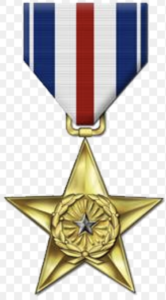 “singular acts of valor or heroism over a brief period, such as one or two days of battle.” If you review Hayden’s wartime activities, you might conclude he should have received three or more Silver Stars.
“singular acts of valor or heroism over a brief period, such as one or two days of battle.” If you review Hayden’s wartime activities, you might conclude he should have received three or more Silver Stars.
In WWII two war lords competed for the soul of Yugoslavia (in the 1990s, Yugoslavia was broken up into Bosnia and Herzegovina, Croatia, Macedonia, Slovenia, and the Federal Republic of Yugoslavia). Hayden supported Josef Broz, popularly known as Tito, who led the Yugoslav partisans, generally regarded as the most successful resistance group in German occupied Europe. I remember reading about Tito when I was a child in the post-war years because he was the European communist of whom America approved.
It was Hayden’s effectiveness, successfully directing a small ship back and forth to Yugoslavia, in a night-time sea filled with German submarines and warships, that led to his Silver Star. After the war Tito presented him with the highest medal offered by Yugoslavia.
If you review Hayden’s wartime record you might well conclude that he should have received there or more Silver Stars. But there are no stories about Sterling Hayden as there are about Jimmy Stewart and the others.
Why are there no World War II Sterling Hayden stories? At the start of the war, both Hayden and his then wife, the world-renowned actress Madeleine Carroll (then, the highest paid actress in the world), legally changed their names to become John and Madeleine Hamilton. They didn’t want any favorable treatment because they were movie stars. Carroll’s sister had been killed early in the war in one of the bombings of London and gave up her career and worked as a Red Cross field nurse for which she was eventually awarded the French Legion d’Honneur and America’s Medal of Freedom (her story is also especially interesting). Sterling Hayden is almost never cited as one of the actors who went to war but, if you look for John Hamilton, you will find one of the most accomplished and heroic of military men.
To say Sterling Hayden was an iconoclast would be one of the great under-exaggerations. He hated rules and conventions and he was almost compulsive in wanting to defy authority. He was also completely ineffective with financial matters throughout his life, refusing to invest his earnings in the stock market because doing so would violate his belief that you shouldn’t earn money for work you did not do yourself. He impulsively spent money when he could not afford to do so. After the war he returned to Hollywood only when he needed money, particularly to support his numerous sea voyages. That was a pattern he would follow for the rest of his life: act to make money, leave Hollywood, return to the sea, act again to make money so he could return to the sea.
He and Madeleine Carroll divorced amicably after the war. Unfortunately, the 1958 divorce of Hayden from his second wife, Betty de Noon, was decidedly acrimonious. Hayden was awarded custody of their four children. As a part of the settlement, however, Hayden was forbidden to take them out of the
country, something he had often publicly stated was his plan. Defying the court
order, he gathered an excellent crew and sailed with the children (see photo at the top) from San Francisco to Tahiti on the schooner, The Wanderer, in January 1959. They didn’t return for 10 months.
In 1960, he married a wealthy New York socialite, Catherine Devine McConnell. He refused to rely on her wealth. They had two children, in addition to his four with de Noon, and, despite a periodically stormy relationship remained married until he died, in 1986, from prostate cancer.
Hayden would have identified himself as a seaman or perhaps as a writer. He would have reluctantly acknowledged that, at least during the war, he was a hero despite thinking, throughout his life, he was a coward. Helpless to control his drinking, he would have readily admitted to being an alcoholic. He was a failure as a husband. I’m not sure how he would have considered himself as a father but I have no doubt he gave his children things of great value: a restlessness to succeed, a willingness to explore, a thirst for knowledge, and the courage to find one’s own path in life.
An actor? He would have vehemently argued that he was not and would have cited a host of films to prove the point. I have not seen many of his films but the ones I have seen are proof that he could embody a role and make an audience believe. He could act with skill and intelligence.
He was also a fine writer. Hayden’s 1976 novel, Voyage, was widely acclaimed. Critics compared his writing in this book and then in his autobiography, Wanderer, to that of Herman Melville, Joseph Conrad and Jack London, among others.
There are actors we all acknowledge as exceptional. I have had experiences, usually just a few minutes long or even less, where an actor’s performance has transfixed me, altering the way I look at life and persisting in my memory.
Chaplin more than once. Brando in the back seat of a taxi, telling Rod Steiger as his brother, Charley, “I coulda been a contender.” Streep, as Sophie, on being told the awful choice she would have to make. Olivier on the battlefield at Agincourt exhorting his troops to consider themselves blessed to be there, despite facing almost certain death. Vivian Leigh, with the dark earth of Tara in her hands, promising, vowing, that “Tomorrow is another day.” Those and other performances are seared into my memory, sometimes making me stop and hold my breath as I think of them.
Perhaps the most vivid and moving is Tom Hanks in the last few minutes of Captain Phillips, when he has been rescued from the hands of Somali pirates and is in the sick bay of a great ship where he finally breaks down. There are accumulated lifetimes of acting in those minutes and I always marvel to see that segment and wonder how he did that. I could repeatedly watch Philadelphia or Forrest Gump or Big or other Hanks’ performances and I am in awe of the power this one human has be able to so completely inhabit another life. I have that segment recorded and occasionally rewatch it. Those few minutes in that sick bay demonstrate, for me, a talent and skill that is supernatural. I get a chill.
Similarly, in A Field of Dreams, James Earl Jones stands at the edge of the ball field about to step into the tall corn, about to join the dead Shoeless Joe Jackson his teammates. Jones doesn’t say one word, but, for only a few seconds, he smiles and giggles nervously, his foot poised to take that irrevocable step. I know, had I been with him, I might not have had the strength to avoid taking that step with him. Again, watching it, I always feel a chill. What acting!
Sterling Hayden’s imprint may not have been the same as those others. Many of his performances are forgettable. But there are some outstanding and memorable moments. The Killing. Strangelove. The Godfather.
And as the mortally wounded fugitive, Dix Handley, in The Asphalt Jungle, struggling to drive home to the farm where he was born, where he knows he will die. A perfect performance by a great actor.
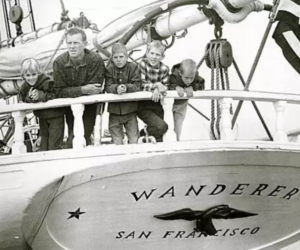
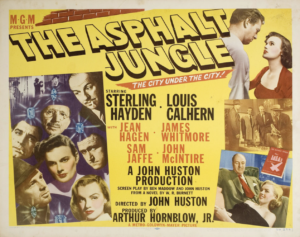
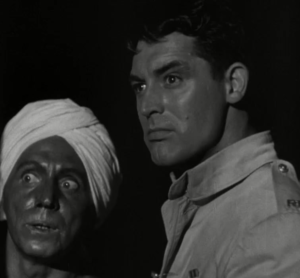
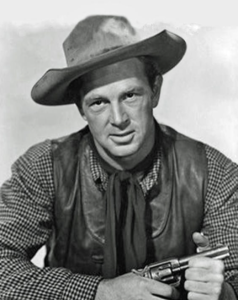
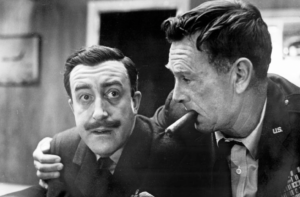

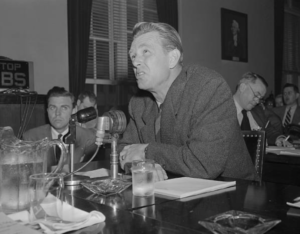
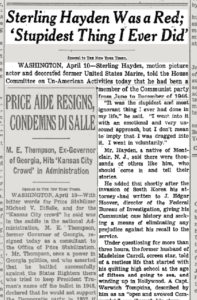
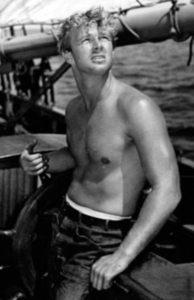
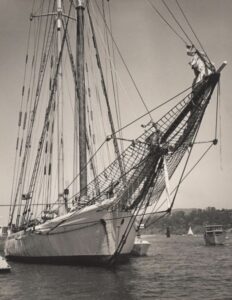
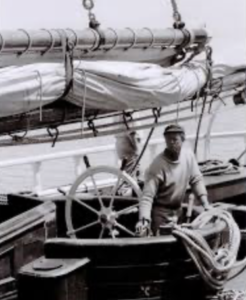
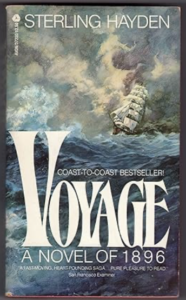
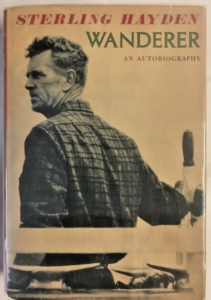
June 6, 2024 at 1:59 pm
your promise of a new post fulfilled! thanks very much for this biography of a person i knew nothing about……and i am extremely impressed by your memory and gratified by
all the insertions in parentheses that define particulars about the ships, etc.
June 8, 2024 at 7:35 am
Despite my not being a movie fan or boating enthusiast, I was enthralled by your essay on Sterling Hayden, a name I only vaguely recalled from my own youthful movie going. Of course, it turned out that he did lead an unusually interesting life, but your ability to ‘bring him to life’ was remarkable. Thanks for another fascinating essay.
June 8, 2024 at 11:38 am
Joel,
Again, many thanks for the kind words. I am pleased that you enjoyed reading about Hayden. In the end, I’m not sure I would have liked him or not. He surely was a powerful presence and probably quite intimidating as a 6’5″ physical and intellectual presence. I do know I regret never having met him and experienced what must have been a powerful ‘force of nature.’
Best wishes.
Stephen